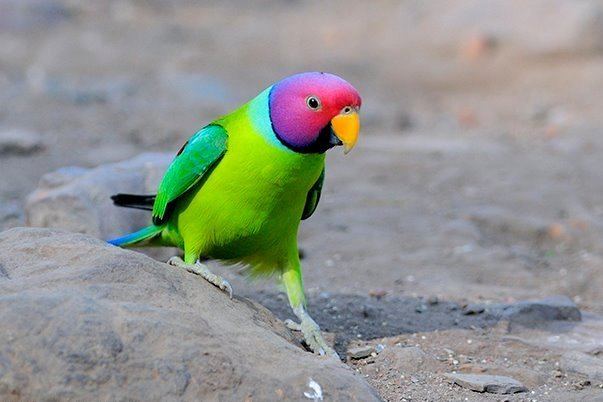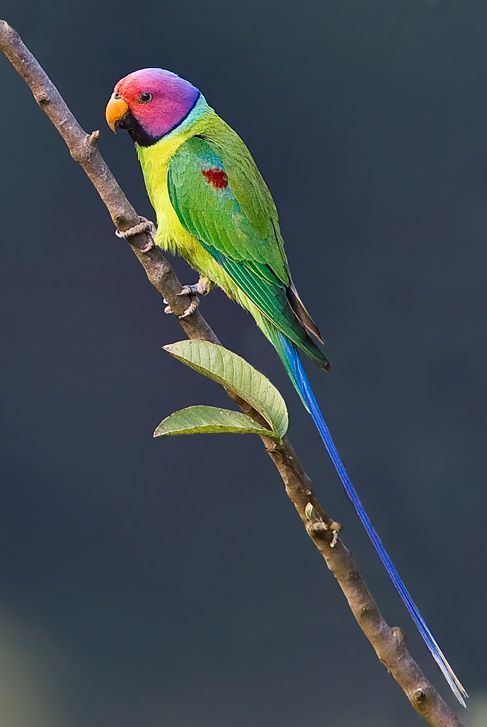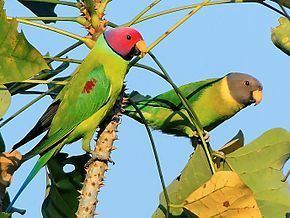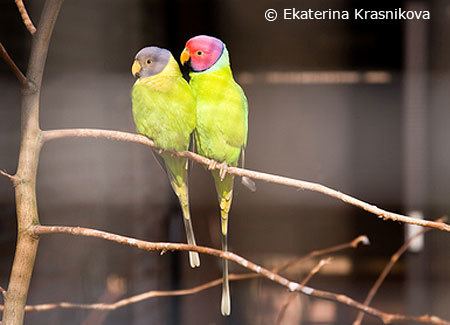Phylum Chordata Rank Species | Higher classification Psittacula Order Parrot | |
 | ||
Similar Bird, Parrot, Psittacula, Rose‑ringed parakeet, Slaty‑headed parakeet | ||
Plum headed parakeet mating
The plum-headed parakeet (Psittacula cyanocephala) is a parakeet endemic to the Indian Subcontinent. Along with Psittacula roseata of the Himalayas it was sometimes known by the name of blossom-headed parakeet which is now used to refer only to Psittacula roseata. Plum-headed parakeets are found in flocks, the males having a pinkish purple head and the females, a grey head. They fly swiftly with twists and turns accompanied by their distinctive calls.
Contents
- Plum headed parakeet mating
- Plum headed parakeet talking
- Description
- Habitat and distribution
- Behaviour and ecology
- References

Plum headed parakeet talking
Description

The plum-headed parakeet is a mainly green parrot, 33 cm long with a tail up to 22 cm. The male has a red head which shades to purple-blue on the back of the crown, nape and cheeks while the female has blueish-gray head. There is a narrow black neck collar with verdigris below on the nape and a black chin stripe that extends from the lower mandible. There is a red shoulder patch and the rump and tail are bluish-green, the latter tipped white. The upper mandible is orangish-yellow, and the lower mandible is dark. The female has a dull bluish grey head and lacks the black and verdigris collar which is replaced by yellow. The upper-mandible is corn-yellow and there is no black chin stripe or red shoulder patch. Immature birds have a green head and both mandibles are yellowish. The dark head is acquired after a year. The delicate bluish red appearance resembling the bloom of a peach is produced by a combination of blue from the optical effects produced by the rami of the feather and a red pigment in the barbules.

Some authors have considered the species to have two subspecies, the nominate from peninsular India (type locality restricted to Gingee) and the population from the foothills of the Himalayas as bengalensis on the basis of the colour of the head in the male which is more red and less blue. Newer works consider the species to be monotypic.

The different head colour and the white tip to the tail distinguish this species from the similar blossom-headed parakeet (Psittacula roseata). The shoulder patch is maroon coloured and the shorter tail is tipped yellow in P. roseata.

A supposed species of parakeet, the so-called intermediate parakeet Psittacula intermedia is thought to be a hybrid of this and the slaty-headed parakeet (Psittacula himalayana).
Habitat and distribution

The plum-headed parakeet is a bird of forest and open woodland, even in city gardens. They are found from the foothills of the Himalayas south to Sri Lanka. They are not found in the dry regions of western India. They are sometimes kept as pets and escaped birds have been noted in New York, Florida and in some places in the Middle East.
Behaviour and ecology
The plum-headed parakeet is a gregarious and noisy species with range of raucous calls. The usual flight and contact call is tuink? repeated now and then. The flight is swift and the bird often twists and turns rapidly. It makes local movements, driven mainly by the availability of the fruit and blossoms which make up its diet. They feed on grains, fruits, the fleshy petals of flowers (Salmalia, Butea) and sometimes raid agricultural fields and orchards. The breeding season in India is mainly from December to April and July to August in Sri Lanka. Courtship includes bill rubbing and courtship feeding. It nests in holes, chiselled out by the pair, in tree trunks, and lays 4–6 white eggs. The female appears to be solely responsible for incubation and feeding. They roost communally. In captivity it can learn to mimic beeps and short whistling tunes, and can talk very well.
Neoaulobia psittaculae, a quill mite, has been described from the species. A species of Haemoproteus, H. handai, has been described from blood samples from the plum-headed parakeet.
